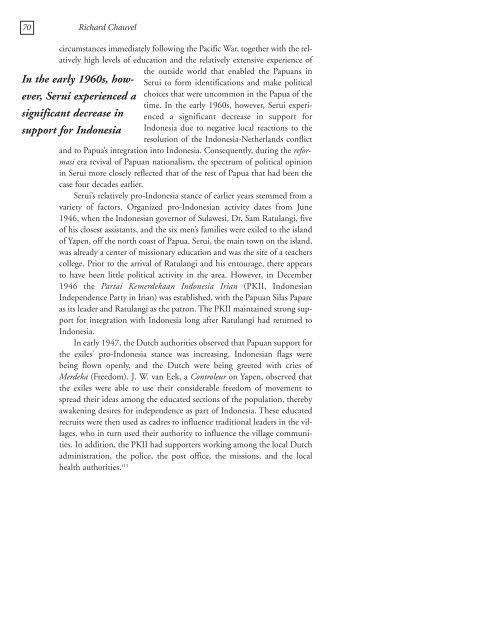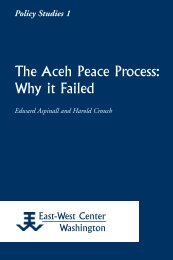Constructing Papuan Nationalism: History, Ethnicity ... - ScholarSpace
Constructing Papuan Nationalism: History, Ethnicity ... - ScholarSpace
Constructing Papuan Nationalism: History, Ethnicity ... - ScholarSpace
- No tags were found...
Create successful ePaper yourself
Turn your PDF publications into a flip-book with our unique Google optimized e-Paper software.
70 Richard Chauvelcircumstances immediately following the Pacific War, together with the relativelyhigh levels of education and the relatively extensive experience ofthe outside world that enabled the <strong>Papuan</strong>s inSerui to form identifications and make politicalchoices that were uncommon in the Papua of thetime. In the early 1960s, however, Serui experienceda significant decrease in support forIndonesia due to negative local reactions to theresolution of the Indonesia-Netherlands conflictand to Papua’s integration into Indonesia. Consequently, during the reformasiera revival of <strong>Papuan</strong> nationalism, the spectrum of political opinionin Serui more closely reflected that of the rest of Papua that had been thecase four decades earlier.Serui’s relatively pro-Indonesia stance of earlier years stemmed from avariety of factors. Organized pro-Indonesian activity dates from June1946, when the Indonesian governor of Sulawesi, Dr. Sam Ratulangi, fiveof his closest assistants, and the six men’s families were exiled to the islandof Yapen, off the north coast of Papua. Serui, the main town on the island,was already a center of missionary education and was the site of a teacherscollege. Prior to the arrival of Ratulangi and his entourage, there appearsto have been little political activity in the area. However, in December1946 the Partai Kemerdekaan Indonesia Irian (PKII, IndonesianIndependence Party in Irian) was established, with the <strong>Papuan</strong> Silas Papareas its leader and Ratulangi as the patron. The PKII maintained strong supportfor integration with Indonesia long after Ratulangi had returned toIndonesia.In early 1947, the Dutch authorities observed that <strong>Papuan</strong> support forthe exiles’ pro-Indonesia stance was increasing. Indonesian flags werebeing flown openly, and the Dutch were being greeted with cries ofMerdeka (Freedom). J. W. van Eek, a Controleur on Yapen, observed thatthe exiles were able to use their considerable freedom of movement tospread their ideas among the educated sections of the population, therebyawakening desires for independence as part of Indonesia. These educatedrecruits were then used as cadres to influence traditional leaders in the villages,who in turn used their authority to influence the village communities.In addition, the PKII had supporters working among the local Dutchadministration, the police, the post office, the missions, and the localhealth authorities. 113In the early 1960s, however,Serui experienced asignificant decrease insupport for Indonesia
















